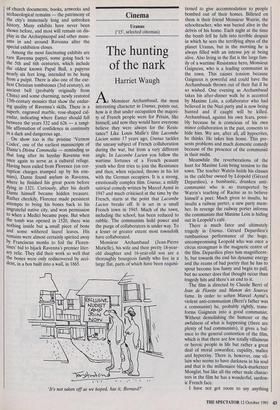Exhibitions 2
Hidden Treasures (San Vitale, Ravenna, till 17 November)
The glory that was Ravenna
Roderick Conway Morris
It is as well Edward Gibbon was Hono- rius's chronicler and not his adviser. The historian roundly condemned this emper- or's decision, in 402 AD, to transfer the capital of what was left of the western Roman Empire to Ravenna, regarding the move as exasperatingly effeminate and lily- livered. In reality the choice proved a shrewd one: it guaranteed that the light of Romano-Christian civilisation was never extinguished in Italy, and the precious An illuminated 12th-century Bible from the Ravenna region flame preserved till the time came to roll back the tides of barbarism.
Sixteen hundred years ago Ravenna was a Venice avant la lettre: built on piles, with canals and bridges, surrounded by salt marshes and lagoons. The place was impregnable to attack and its port assured a perpetual lifeline to Constantinople and
the Empire in the east. So while Rome was repeatedly sacked, until it was reduced to little more than a glorious name clinging to a derelict ghost town, Ravenna thrived and provided a haven for culture and civility.
Not everyone was enamoured of the place, it is true. 'In that marshland', wrote the 5th-century, Lyons-born Sidonius Apol- linaris, 'the laws of nature are continually turned upside down: the walls fall and waters stand, towers float and ships are grounded, the sick promenade and physi- cians lie abed, the baths freeze and houses burn, the living go thirsty and the buried swim.' Nevertheless, this last hope of the West rapidly emerged as a kind of fortified showcase of superior culture and values, like some jewel-encrusted reliquary, glitter- ing invitingly amidst encompassing swamps and mists, tantalisingly visible but just beyond the invader's grasp.
Ravenna had been one of the first cities in Italy to embrace Christianity (preceded only by Rome and Naples), and following Honorius's momentous edict numerous new churches, adorned with stupendous mosaics, began to rise up. The process was crowned in the 6th century, when the Byzantine Emperor Justinian's general Belisarius won back much of the peninsula for the Empire, Ravenna became an Exar- chate and Byzantium, then at the height of its architectural and artistic powers, added its riches to this already extraordinary place. Happily, the favoured decorative medium was mosaic, whose durability assured its survival until the present day, while fresco would have long ago decayed in Ravenna's winter fogs and summer heat.
What remains now is less than a third of what there once was, yet still, after a day spent gazing at churches, one comes away dazzled by the, beauty and sumptuousness of it all. At least one barbarian found the spell irresistible. When Theodoric, an illit- erate Ostrogoth, albeit a Christian one, took over its government in 493 with the blessing of the Byzantine Emperor Zeno, he threw himself into a frenzy of civic and ecclesiastical construction, giving the city one of its finest churches, S. Apollinare Nuovo, and developed a positively patri- cian interest in aqueducts, telling the peo- ple that 'now we shall have Baths again that we can look upon with pleasure . . . drinking water too, such as the mere sight of it will not take away appetite for food'.
The coronation in Rome in 800 of Charlemagne as Holy Roman Emperor was the symbolic event that signalled the end of Ravenna's primacy as the bastion of the West, though it remained an important artistic and religious centre (its missionar- ies being responsible for the conversion of the Poles). But gradually the city sank into provincial obscurity, even the sea deserting it, leaving it stranded several miles inland on a vast and featureless plain.
The 'hidden treasures' of the present exhibition's title are the unique collection of church documents, books, artworks and archaeological remains — the patrimony of the city's immensely long and unbroken history. Many exhibits have never been shown before, and most will remain on dis- play in the Archiepiscopal and other muse- ums in and around Ravenna after the special exhibition closes.
Among the most fascinating exhibits are rare Ravenna papyri, some going back to the 5th and 6th centuries, which include the oldest known Papal Bull, a papyrus nearly six feet long, intended to be hung from a pulpit. There is also one of the ear- liest Christian tombstones (3rd century), an ancient bell (probably originally from China) and some charming, newly restored 13th-century mosaics that show the endur- ing quality of Ravenna's skills. There is a superb, engraved marble, rose-shaped cal- endar, indicating where Easter should fall between the years 532 and 626 — a tangi- ble affirmation of confidence in continuity in a dark and dangerous age.
On show too is the pristine 'Vernon Codex', one of the earliest manuscripts of Dante's Divina Commedia — reminding us that long after its heyday Ravenna was once again to serve as a cultural refuge. Having been exiled from Florence (on cor- ruption charges trumped up by his ene- mies), Dante found asylum in Ravenna, where he finished his great poem before dying in 1321. Curiously, after his death Dante himself became hidden treasure. Rather cheekily, Florence made persistent attempts to bring his bones back to his ungrateful native city, and won permission to when a Medici became pope. But when the tomb was opened in 1520, there was nothing inside but small piece of bone and some withered laurel leaves. His remains were almost certainly spirited away by Franciscan monks to foil the Floren- tines' bid to hijack Ravenna's premier liter- ary relic. They did their work so well that the bones were only rediscovered by acci- dent, in a box built into a wall, in 1865.
`It's not taken off as we hoped, has it, Bernard?'



























































 Previous page
Previous page